You need some education. Equating the Dolby noise reduction system ( you need to learn how that worked it wasnt single ended), with multichannel movie sound is ridiculous.
Be nice. It's a common mistake, besides, movies used both. 🙂
Also, you missed 70mm and 35 mm magnetic in your listing. 🙂
70mm film shipped exclusively with magnetic sound tracks, requiring a separate magnetic pick-up head, as opposed to the two optical channels.
There was also a very rarely used 35 mm magnetic format as well. Among the rare exemplars of this was The Natural and (don't blame me) Caligula.
I was refering to post analogue systems. And i apoligize for the rudeness but it bugs me when people with limited knowledge dish technologies or companiies like Dolby they know nothing about.
Utter rubbish. I run speakers that are CD down to 350Hz or so, ie just above Schroeder, and sound centred on the screen sounds just like that, ie, centred.If you have only stereo speakers, the dialog comes from both sides of the screen (maybe meters between the L&R speakers and the tv) and that's not natural.
Regardless of having 2 ears in real life most sounds come from a mono source. IMO voice intelligibility sounds the most coherent from a single source like a center channel.
Hey Plano,
Speaking of being nice, I was a little curt about steering, sorry. Once of the problems with critical listening is you start to hear the gear more than the movie. After a few hours of playing in the guts of a theater steering mechanism I became sensitive to what a lot of other people never would notice. Lucky them!
My bad,
Erik
Speaking of being nice, I was a little curt about steering, sorry. Once of the problems with critical listening is you start to hear the gear more than the movie. After a few hours of playing in the guts of a theater steering mechanism I became sensitive to what a lot of other people never would notice. Lucky them!
My bad,
Erik
That's exactly what I wrote wasn't it? Sound from both (left and right) speakers arrives at both (left and right) ears. Left speaker -> left and right ears. Right speaker -> left and right ears.Unfortunately this is incorrect too. Stereo is dependent on the sound from both loudspeakers arriving at BOTH ears.
HRTF allows us to distinguish the direction of left and right speaker sources even though the levels of each are similar at both ears. In the case of both sources playing coherent/mono sound, a single virtual source can be perceived having a location dependant on the volume, time of arrival and perceived direction of both sources.
Last edited:
Regardless of having 2 ears in real life most sounds come from a mono source. IMO voice intelligibility sounds the most coherent from a single source like a center channel.
This is at the heart of unpacking why 2-channel stereo works as a parlor trick in the first place. At its most simple level, 2-channel can create a convincing simulacrum of an acoustic event because when employed to that end, it’s pros (interaural time and amplitude delay) outweigh its cons (interaural crosstalk, comb filtering). There’s a fair argument to be made that adding a third channel is beyond the point of diminishing returns. Regardless, there’s an even better argument that having the intended playback setup for which the media was mixed and mastered in is more in the spirit of high fidelity than rejecting any such paradigm altogether.
The earliest I could find when I realised the phantom image I was getting, was a post from 2013 and the first shown speaker corresponds to what I was using at the time. It was my third generation waveguide prototype. I was trying to reduce diffraction and reflections.And now we all want to know; whats speaker du you use? 🙂
This later evolved into the built in ellipsoidal.AllenB said:because I'm trying to judge a speaker by listening in mono for changes that happen with level,
Attachments
That's exactly what I wrote wasn't it? Sound from both (left and right) speakers arrives at both (left and right) ears. Left speaker -> left and right ears. Right speaker -> left and right ears.
HRTF allows us to distinguish the direction of left and right speaker sources even though the levels of each are similar at both ears. In the case of both sources playing coherent/mono sound, a single virtual source can be perceived having a location dependant on the volume, time of arrival and perceived direction of both sources.
No, you wrote "The problem with stereo speakers is that the sound from the left and right speakers arrives at both the left and right ears". My point was that this is definitely not a problem, it is the fundamental basis of how stereo works and the subject of widespread misunderstanding.
It also has little to do with HRTFs (at least in the low frequency range). Stereo implores identical sound pressures magnitudes at both ears (rendering its directional localisation effect via the phases of those sound pressures). HRTFs are often accompanied by "stereo cross-cancellation filters" with the express intention of (as the name suggests) removing the stereo effect.
Just like localisation at high frequencies, confusion abounds!
No, you wrote "The problem with stereo speakers is that the sound from the left and right speakers arrives at both the left and right ears". My point was that this is definitely not a problem, it is the fundamental basis of how stereo works and the subject of widespread misunderstanding.
It also has little to do with HRTFs (at least in the low frequency range). Stereo implores identical sound pressures magnitudes at both ears (rendering its directional localisation effect via the phases of those sound pressures). HRTFs are often accompanied by "stereo cross-cancellation filters" with the express intention of (as the name suggests) removing the stereo effect.
Just like localisation at high frequencies, confusion abounds!
Cool - thanks!
//
No, you wrote "The problem with stereo speakers is that the sound from the left and right speakers arrives at both the left and right ears". My point was that this is definitely not a problem, it is the fundamental basis of how stereo works and the subject of widespread misunderstanding.
It also has little to do with HRTFs (at least in the low frequency range). Stereo implores identical sound pressures magnitudes at both ears (rendering its directional localisation effect via the phases of those sound pressures). HRTFs are often accompanied by "stereo cross-cancellation filters" with the express intention of (as the name suggests) removing the stereo effect.
Just like localisation at high frequencies, confusion abounds!
Could you kindly explain why reducing the crosstalk at the ears actually leads to improved intelligibility of the phantom center, improves the tonal balance across the entire stage (left panned, phantom mid and right panned sounds) and projects a more 'believable' stage than a regular stereo setup does?
A single channel measurement at ear position in a well treated room:
A sweep from both channels at ear position:
mains only (Green), with Kickers (Orange) and with my Kickers + Ambient channels (Red)
Stereo needs some level of reflections to fill in the holes that stereo cross talk exhibits. In this example we see the results from within jim1961's room with hardly any early reflections at all. The Kicker (a Haas Kicker setup meticulously to deliver late reflections but within Haas limits) fills in those holes as well (live end/dead end setup) and a later ambient speaker adition does as well. Original post: https://www.diyaudio.com/forums/multi-way/277519-fixing-stereo-phantom-center-61.html#post4746283
If we take away those early reflections from a Stereo setup within our room, the tonal balance difference between side sounds and phantom sounds become quite obvious. However if you compensate for that cross talk effect (not completely remove it), things start to work remarkably well.
As said, improved intelligibility, improved tonal balance and 'holographic like' imaging that exceeds the boundaries of the room. I'd still call it Stereo and I'm pretty sure it wasn't a secret to Blumlein.
If you see the second graph, an equal triangle Stereo setup with both speakers playing as measured at ear position, the dip that is quite popular to include in speaker design, often called the BBC dip is starting to make a lot of sense.
Attachments
Last edited:
Please don't post images 3000 pixels wide. The forum software does a bad job of resizing them. Thanks.
It was just a repost from the Phantom Centre thread, I had no idea they were this big. I'll fix it.
There are benefits to running a centre speaker for HT use and I used to run 6.1 with same drivers for the 6 but now only use 4.1.2(presence). The centre speaker was under the screen but tilted to be acoustically in line with the fronts. I've also tried 2 centre speakers beside the screen. Now my HT fronts are next to the screen with the main stereo speakers out wider.
Location of the centre speaker can be a problem for some with it too low or high as well as tonally matching the fronts. In my case it was removed as my main stereo coexists in the same rack so the centre had to go to make room for other components.
There is also help in the AV receiver such as dialogue level and lift which helps to make up for the loss of the centre. Personally I haven't missed it but I do not have a dedicated theatre room. Even so, I still enjoy the sound from my movies as still gives a good presentation.
Location of the centre speaker can be a problem for some with it too low or high as well as tonally matching the fronts. In my case it was removed as my main stereo coexists in the same rack so the centre had to go to make room for other components.
There is also help in the AV receiver such as dialogue level and lift which helps to make up for the loss of the centre. Personally I haven't missed it but I do not have a dedicated theatre room. Even so, I still enjoy the sound from my movies as still gives a good presentation.
Could you kindly explain why reducing the crosstalk at the ears actually leads to improved intelligibility of the phantom center, improves the tonal balance across the entire stage (left panned, phantom mid and right panned sounds) and projects a more 'believable' stage than a regular stereo setup does?
A single channel measurement at ear position in a well treated room:
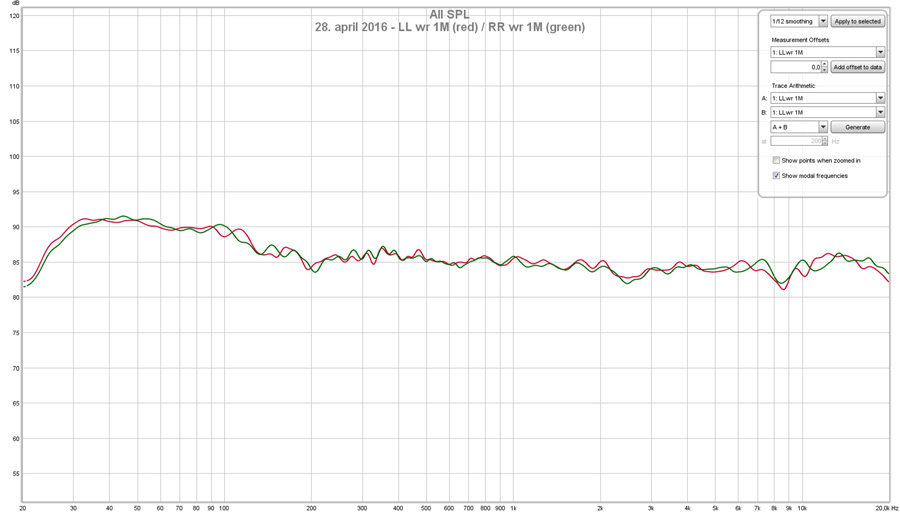
A sweep from both channels at ear position:
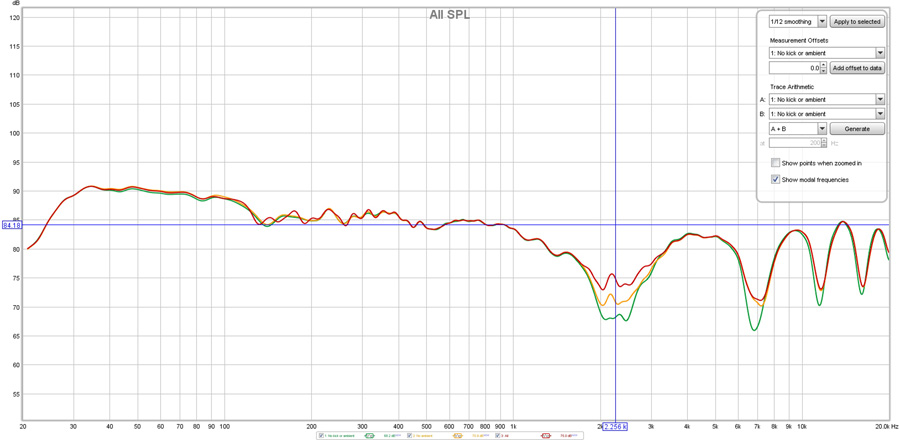
Stereo needs some level of reflections to fill in the holes that stereo cross talk exhibits. In this example we see the results from within jim1961's room with hardly any early reflections at all. The Kicker (a Haas Kicker setup meticulously to deliver late reflections but within Haas limits) fills in those holes as well (live end/dead end setup) and a later ambient speaker adition does as well. Original post: https://www.diyaudio.com/forums/multi-way/277519-fixing-stereo-phantom-center-61.html#post4746283
If we take away those early reflections from a Stereo setup within our room, the tonal balance difference between side sounds and phantom sounds become quite obvious. However if you compensate for that cross talk effect (not completely remove it), things start to work remarkably well.
As said, improved intelligibility, improved tonal balance and 'holographic like' imaging that exceeds the boundaries of the room. I'd still call it Stereo and I'm pretty sure it wasn't a secret to Blumlein.
If you see the second graph, an equal triangle Stereo setup with both speakers playing as measured at ear position, the dip that is quite popular to include in speaker design, often called the BBC dip is starting to make a lot of sense.
I can explain 🙂 Although there are many different facets to your questions, so I hope I manage to get them all answered well enough here...
Accurate conventional stereo reproduction is confined to low frequencies (that is to wavelengths less than the diameter of the head). In this region, the phase difference at the ears from two (or more) stereo loudspeakers is exactly that produced by a single source at some angle between the loudspeakers. The relationship is not linear but characterised by the "stereophonic law of tangents" obtained from analysing the velocity of the sound (that is its directional (vector) components). Nevertheless in this range, stereo replay can demonstrate ample horizontal localisation properties.
At higher frequencies, phase alone is no longer sufficient and (as I will get to later) the phase can offer many confusing localisation cues. In the region above 400-800Hz, a velocity vector model is then also no longer apt for analysis. Michael Gerzon proposed a hierarchical model instead with a transition to an "energy vector" for the region starting from the velocity model transition. (See his JAES paper I think called "Metatheory of Audio Localisation" but which was originally written in the 1970s as a precursor to the development of Ambisonics).
The energy vector model is also intriguing because it ties in with the "shuffler" - a necessary element of accurate stereo reproduction that has become infamously absent from audio equipment. The shuffler was formalised after Blumlein's death and comprises a 3dB reduction in stereo width, which is exactly that suggested by the "energy vector" model. Why it is not better known and more widely adopted is anyone's guess - especially given its simplicity and effectiveness in increasing the frequency range over which stereo can be considered "accurate".
At higher frequencies, say above 1600Hz, Gerzon's model expands into higher order models, for which the simple shuffler does not compensate. Instead some simple remedies can suffice to ameliorate the short comings in stereo at these frequencies. One such example technique filters the high frequency difference signal to account for head shadowing (that is absent for signals emanating from loudspeakers in front of the listener). Some older equipment that had capacitive coupling between channels became renowned for its imaging qualities because of this effect.
Essentially these higher frequency techniques tend to attenuate the encoded stereo and move towards binaural/transaural methods, which while having some validity, are a different technique complete with its own compromises. It is notable that without the head in the way, stereo would provide much better localisation at higher frequencies too (but removing one's head is not recommended for the DIY enthusiast).
And whilst improving localisation and its consistency in frequency might improve intelligibility, I believe your questions allude mainly to the comb filtering inherent in stereo. The first null of the phantom centre occurs in a conventional stereo set up at about 2kHz and is repeated at integer multiples above that. Reducing "crosstalk" then has the additional effect of reducing the effects of that comb filtering.
Keep in mind here too that the stereo information (the difference between L and R) produces a different comb filtering action with a complimentary frequency response to the sum of the L and R channels. And with the tending towards transaural reproduction, attenuation of these nulls will aid imaging "beyond the loudspeakers" - intended or otherwise.
Perhaps more interesting to this thread is to consider that at each (L+R) comb null, the phantom image is no longer apparent since the stereo localisation cues have been attenuated. Instead at these frequencies we hear the same "in head/at the ears" (bi)lateral localisation produced by headphones. Between the nulls, localisation moves with frequency from one extreme to the other, but also as each null is passed, provides additional ambiguity since there is an extra number of possibilities of wavelengths that would produce the signals apparent at the ears.
This spatial sampling and aliasing was first published in the audio world by Edeko et al in their 1985 JAES paper. The paper neatly compares stereo to the method of wavefront reconstruction where the spatially aliased ambiguities are defined mathematically. Important to the questions here, however, is that crosstalk filtering reduces this ambiguity and produces a more believable stereo image and increases the perception of transaural localisation cues (whether they be consistent with the stereo encoding or not).
Even this improvement must come with some caution, however. As you point out, room reflections and dispersion from, say, line sources can ameliorate the comb filtering effects by essentially "filling in the holes" in the frequency response. But this is to smear the signal at the ears. That is to say, by compromising the fidelity of the reproduction in time, we can arrive at a situation where other elements are perceived with greater clarity. Even smearing localisation over a broad frequency range can have the effect of increasing clarity in certain circumstances.
And so to return to the central tenet of the thread (which also echoes many of my contributions to the "Fixing the phantom center" thread), there exists no better way to ameliorate all of these issues than via three speaker stereo. Not all three-speaker arrangements are the same, however, or even likely to offer an improvement, but when engineered properly they can be.
Is it stereo? Not as rigourously defined. But then without a shuffler present, how many conventional two-speaker systems are?
Last edited:
- Home
- Loudspeakers
- Multi-Way
- What is the point of a centre speaker?
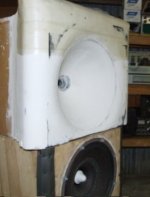
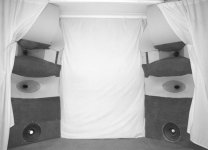
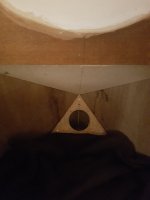
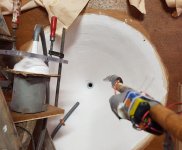
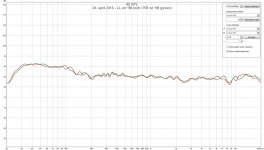
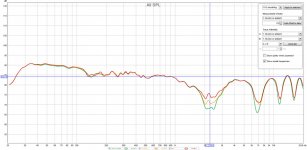
 Of course now they are displaying correctly. Jeez this forum software is funky.
Of course now they are displaying correctly. Jeez this forum software is funky.